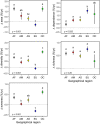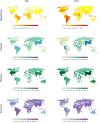Global agricultural productivity is threatened by increasing pollinator dependence without a parallel increase in crop diversification
- PMID: 31293015
- PMCID: PMC6852307
- DOI: 10.1111/gcb.14736
Global agricultural productivity is threatened by increasing pollinator dependence without a parallel increase in crop diversification
Abstract
The global increase in the proportion of land cultivated with pollinator-dependent crops implies increased reliance on pollination services. Yet agricultural practices themselves can profoundly affect pollinator supply and pollination. Extensive monocultures are associated with a limited pollinator supply and reduced pollination, whereas agricultural diversification can enhance both. Therefore, areas where agricultural diversity has increased, or at least been maintained, may better sustain high and more stable productivity of pollinator-dependent crops. Given that >80% of all crops depend, to varying extents, on insect pollination, a global increase in agricultural pollinator dependence over recent decades might have led to a concomitant increase in agricultural diversification. We evaluated whether an increase in the area of pollinator-dependent crops has indeed been associated with an increase in agricultural diversity, measured here as crop diversity, at the global, regional, and country scales for the period 1961-2016. Globally, results show a relatively weak and decelerating rise in agricultural diversity over time that was largely decoupled from the strong and continually increasing trend in agricultural dependency on pollinators. At regional and country levels, there was no consistent relationship between temporal changes in pollinator dependence and crop diversification. Instead, our results show heterogeneous responses in which increasing pollinator dependence for some countries and regions has been associated with either an increase or a decrease in agricultural diversity. Particularly worrisome is a rapid expansion of pollinator-dependent oilseed crops in several countries of the Americas and Asia that has resulted in a decrease in agricultural diversity. In these regions, reliance on pollinators is increasing, yet agricultural practices that undermine pollination services are expanding. Our analysis has thereby identified world regions of particular concern where environmentally damaging practices associated with large-scale, industrial agriculture threaten key ecosystem services that underlie productivity, in addition to other benefits provided by biodiversity.
Keywords: agricultural expansion; biodiversity; crop diversity; pollination; pollination services; pollinator-dependent crops.
© 2019 The Authors. Global Change Biology Published by John Wiley & Sons Ltd.
Figures





References
-
- Aizen, M. A. , Biesmeijer, J. C. , Martins, D. J. , Goka, K. , Inouye, D. W. , Jung, C. , … Seymour, C. (2016). The status and trends in pollinators and pollination In Potts S. G., Imperatriz‐Fonseca V. L., & Ngo H. T. (Eds.), The assessment report of the Intergovernmental Science‐Policy Platform on Biodiversity and Ecosystem Services on pollinators, pollination and food production (pp. 151–203). Bonn, Germany: Secretariat of the Intergovernmental Science‐Policy Platform on Biodiversity and Ecosystem Services.
-
- Aizen, M. A. , Garibaldi, L. A. , & Dondo, M. (2009). Expansión de la soja y diversidad de la agricultura argentina. Ecologia Austral, 19, 45–54. 10.1098/rspb.2014.2756 - DOI
Publication types
MeSH terms
LinkOut - more resources
Full Text Sources

